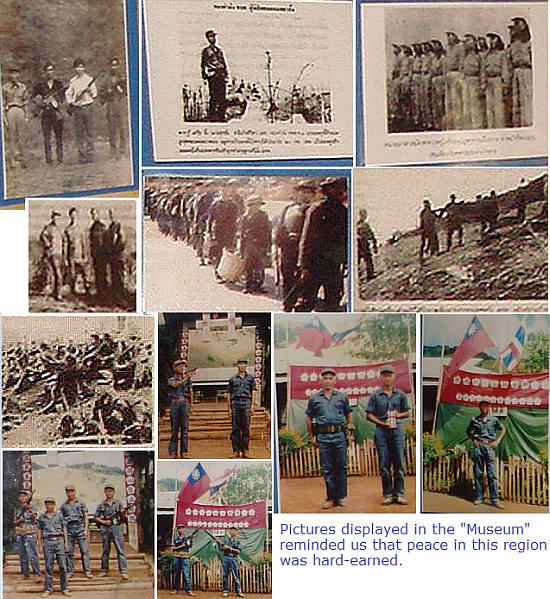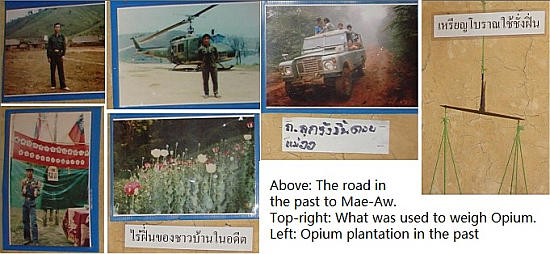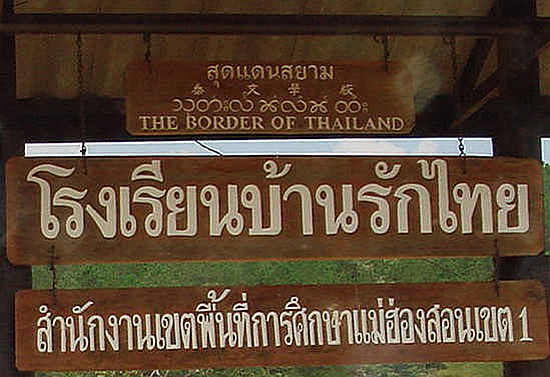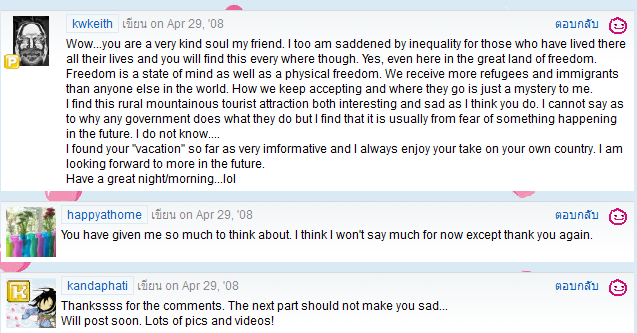My Old Blogs at Yahoo!360 / MTP
Family Trip to Mae Hong Son in April, 2008: Part II
Apr/29/2008
* Notes:
– Reposted at Webs.com on July 30, 2011.)
– Slideshows at webshots were gone.
– Re-coded (with notes added) and posted at Neocities.org on Jul-2-2017.
(Still in a serious mood…)
In the beginning I simply wanted to record what we did, where we went, and what pics and videos we took during our 7-day trip to Mae Hong Son in the northwestern region of this country.However, it turned out to be a lengthy, heavy, and sad blog in Part 1.
And the sadness did not end right there.
I kept remembering the shock I had when I had a glimpse of huge bruises on the skin beneath the knee coils of one of the long-earred women's in Ban Nai Soi village, who was a lot younger than I.
I did not have the nerve to ask or discuss this with any of them then and there as all of them were smiling "happily" when we talked to them.
After I posted Part 1 I googled more for pics of long neck women's bare necks and shoulders when the heavy coils were taken off. I wanted to know how deformed they could be and how to prevent or lessen the damage.
Guess what? I found none!
Are we tourists pressing these ex-refugees into preserving their "tradition"?
I now wish we had visited there not for the purpose of taking pics of those deformed women but to see OTHER cultural aspects of theirs…
Come to think of it, I hardly know anything else about their culture!
As long as humans have wars there is always the need to set up shelter areas for people fleeing from wars into our country. Ideally these areas should be temporary. But since ancient time most wars never end easily.
Imagine long years of living inside a confined shelter area that is called refugee camp. Imagine younger generation(s) born and brought up in the camp without knowing what life outside the camp is.
No matter how unkind our government may appear in the eyes of some humanity groups it is out of consideration of our government's to issue "hill tribe IDs" to some of the refugees and their offspring who have been in the restricted area inside refugee camps for many years without any hope of returning to their country safely.
With such IDs they are allowed to leave the camp and come to the villages that our government has set up for them. These people are granted more freedom than the refugees inside the camps. They can work and earn income for themselves and their families. They do not have to worry about being deported to their war-torn country against their wish.
In my opinion, if the refugees want to depart for the third country that has accepted them they should be free to go. It is ridiculous not to let them go. And it is cruel and inhuman for anyone to make profits on refugees.
On the other hand, should those that have had hill tribe IDs for many years, who have been obeying Thai laws, want to have all the rights and benefits a Thai citizen has, they should by all means be granted Thai citizenship or nationality. There is no reason our government refuses to do this for them. Red tapes should not be long.
I hope I have said nothing wrong here.
If you have been to Golden Triangle in Chiang Rai in northern Thailand, and Ban Rak Thai in Mae Hong Son, you will agree with me on the above. Without these refugees' contributions the remote places deep in the high mountains would have been nothing but land of wilderness instead of well-known tourism spots with good facilities.
Ban Rak Thai
I am glad we visited Ban Rak Thai.("Ban" = village, "Rak Thai" = Love Thailand)
The place is near the border, very far up in the mountain.
Here are some pics:
Mud house shops built in traditional Chinese way:
This is the shop that we went in and had our lunch.
Delicious!
The green sign was the warning for forest fire.
Enlarged below is the sign under the village name.
"Border of Siam at Mae Aw, Rak Thai. Welcome. Free tea tasting at all shops. "

Certainly not "TESTING", haha. K.M.T. is "Kuomintang".
* Here is a very good article about the K.M.T. in northern Thailand:
In Remote Thai Villages, Legacy of China's Lost Army Endures
by Amy Qin, posted on Jan 14, 2015. You can read this later...
Despite the region's heavy history, in reality we were greeted with happy faces.
Here is a pic of me with a lady from one of the shops in Ban Rak Thai.
I had met this lady once in our family's first visited to that sightseeing (?) village in the winter of 2004. She was the sales person of a Chinese shop-&-restaurant.
Ban Rak Thai was made up mainly of ex-refugees from Yunnan, southern China. There were also other hill tribes in the village. The place was very high up in the mountain. It was not easy to get there.
In our first meeting in 2004, I was impressed with the lady's fluency in Chinese. She said she was not Chinese, but of another hill tribe.
I had known that the kids in the Chinese (refugees') villages in Chiang Rai and Mae Hong Son went to Thai school in the daytime just like all the kids in Thailand, and these children continued to study in Chinese schools in the evening, therefore they were fluent both in Thai and Chinese.
The lady told me she could speak at least 3 languages: Thai, Chinese, and her own tribal language. She said when younger, besides Thai school she also went to Chinese school in the village.
I had not known that non-Chinese hill tribe kids would also attend Chinese school.
It was kind of surprising we both instantly remembered each other when we met again in 2008.
This time I found her more tanned and more lively. She was really good at her job. My family and I ended up buying many things from her -- including a set of beautiful teapot and tea cups from China.
In my opinion there is no reason she and other people like her should not be granted Thai citizenship. Maybe they already have gotten that.
Thanks to these people the jungle near the border in NW of Thailand has become civilized.
Back to my conversation with that lady… I asked her where the villagers go when they were very sick. She told me if really sick they had to be sent to the hospital in town.
Goodness, that was so faaaaaaaaar away!
Before they can have any good hospitals nearby I pray that all of them are always in excellent health.
There was a very nice reservior in Ban Rak Thai.
Here I am in front of a shop by the reservior:
It was hot! But in winter it was very cool.
There was a sign pointing to Jee-Lee (="Good luck") Restaurant.
This is Jee-Lee Restaurant across the reservior.
It looked more "modern", but we did not eat here.
Me in front of some warning signs.
Sign on the right said Thai cigarettes on sale on the other side of border were all fake as our government did not encourage export of them.

Sign on the left was our King's word:
The harm from narcotics is most severe, let's get together to solve this problem ASAP… (Sorry, my translation is not good enough.)

This is the museum of the village.
Very small, but there were lots of sad memories here.
Inside the museum.
Enlarged:

Pics inside the museums showed what the village was like in the past.
Enlarged:


There was a pic of opium plants. These plants do not exist now. They have long been replaced by tea and other veggies.
Restaurants were everywhere! This one is next to the museum.
Ban Rak Thai School across the museum.
The green sign on the left :
"Bank of Ban Rak Thai School -- supported by BAAC ( = Bank for Agriculture and Agricultural Cooperatives ) Mae Hong Son Branch".
School sign enlarged:

In the above:
First row in Thai can be translated literally as "On the border of Siam".
The word "Siam" is seen on many signs in this region. Very nostalgic.
Second row written in traditional in Chinese (Obvious KMT's influence here) said "Thai School". I am not sure if it has been changed to China mainland's simplified letters these days.
I have zero knowledge of the circular letters on the line between the Chinese and English. Are they Karen, Mon, Shan, or?
– End of part two –
Screenshot of the comments at MTP :


← Part I
Part III →
The Top The List Kanda's at Neocities.org